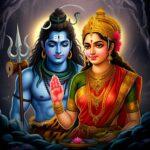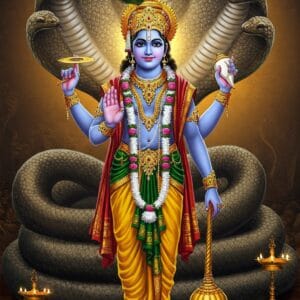Description
Lord Shiva Parvati Devi at Kailash Lok
Image Prompt: “An AI-generated artwork depicting Lord Shiva and Goddess Parvati. Shiva is shown with his characteristic blue complexion, a serene expression, the crescent moon adorning his matted locks from which the Ganga flows, a serpent coiled around his neck, and holding his trident (Trishula). Goddess Parvati, resplendent in a vibrant saree and traditional jewelry, stands beside him, her hand raised in a gesture of blessing or reassurance. The background is ethereal, suggesting a divine realm.”
Divine Union in the Digital Age: An AI’s Vision of Shiva and Parvati
In an era where technology and tradition increasingly intertwine, a striking image has emerged from the digital canvas of Artificial Intelligence: a depiction of Lord Shiva and Goddess Parvati. This isn’t just another piece of art; it’s a conversation starter, a blend of ancient reverence and cutting-edge creation. As we delve into this AI-generated portrayal, we explore not only its artistic merits but also what it signifies for the future of spiritual art.
A Closer Look: The Artistic Interpretation
The first thing that captures the eye is the vibrant yet ethereal quality of the image. The AI has rendered Lord Shiva with his iconic attributes: the tranquil blue hue of his skin, symbolizing his infinite nature, the crescent moon (Chandra) gracing his hair, the sacred river Ganga flowing from his locks, and the formidable serpent Vasuki adorning his neck. His expression is one of profound calm and introspection, even as his powerful trident stands ready.
Beside him, Goddess Parvati is the epitome of divine grace and strength. Draped in a richly colored saree and adorned with traditional jewelry, her presence is both warm and regal. Her expression, often a delicate aspect for any artist to capture, is here rendered with a soft benevolence, her hand often depicted in a gesture (mudra) that can signify blessings or fearlessness.
The AI’s choice of color palette – deep blues, vibrant reds and greens, and golden highlights – creates a sense of depth and divinity. The interplay of light and shadow adds a mystical aura, making the figures almost seem to emanate an inner luminescence. It’s fascinating to see how algorithms interpret centuries of iconographic tradition, sometimes adhering closely, other times offering a subtle, fresh perspective.
The Unseen Essence: Symbolism in Pixels
Beyond the visual appeal, the image is rich with symbolism, a cornerstone of Hindu iconography.
- Shiva’s Trident (Trishula): Represents the three fundamental powers of creation, preservation, and destruction, as well as the three Gunas (qualities) – Sattva, Rajas, and Tamas.
- The Serpent: Symbolizes controlled power, kundalini energy, and Shiva’s mastery over fear and death.
- The Crescent Moon: Represents the cycle of time and Shiva’s control over it.
- Ganga: The sacred river, personified as a goddess, whose descent Shiva cushioned in his hair, signifies purity and liberation.
- Parvati’s Presence: She is Shakti, the divine feminine energy, the dynamic force that complements Shiva’s ascetic stillness. Together, they represent the Ardhanarishvara, the inseparable union of masculine and feminine energies, the totality of the cosmos.
The AI, in its own way, attempts to bring these profound concepts to visual life. While it may not “understand” the spiritual depth in a human sense, it has clearly been trained on a vast dataset of images and texts that allow it to associate these symbols with the deities.
AI, Art, and Adoration: A New Triad?
The emergence of AI-generated spiritual art like this raises intriguing questions. Can a machine truly create something sacred? Does the intent behind the creation matter as much as the devotion it inspires in the viewer?
For many, art is a conduit to the divine, a way to visualize and connect with higher powers. If an AI-generated image can evoke feelings of reverence, peace, or a deeper connection to one’s faith, its origin might become secondary to its impact. It opens up new avenues for religious expression and makes divine imagery more accessible and adaptable to contemporary aesthetics.









Reviews
There are no reviews yet.